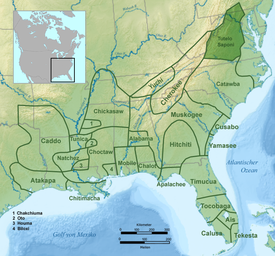 Map showing tribal lands of the Tutelo prior to 1600 | |
| Total population | |
|---|---|
| Extinct as a tribe[1] | |
| Regions with significant populations | |
| West Virginia, Virginia (until 1740s), Ontario (1779-ca. 1900) (descendants assimilated into Cayuga nation) | |
| Languages | |
| Siouan Tutelo language | |
| Related ethnic groups | |
| Occaneechi, Manahoac, Monacan, after 18th century: Cayuga |
The Tutelo (also Totero, Totteroy, Tutera; Yesan in Tutelo) were Native American people living above the Fall Line in present-day Virginia and West Virginia. They spoke a dialect of the Siouan Tutelo language thought to be similar to that of their neighbors, the Monacan and Manahoac nations.
Under pressure from English settlers and Seneca Iroquois, they joined with other Virginia Siouan tribes in the late 17th century and became collectively known as the Nahyssan. By 1740, they had largely left Virginia and migrated north to seek protection from their former Iroquois opponents. They were adopted by the Cayuga tribe of New York in 1753.[2][1] Ultimately, their descendants migrated into Canada.[1]